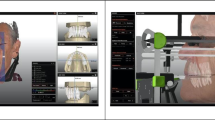Abstract
The purpose of this study was to investigate the influence of the abutment angulation upon the strain distribution pattern for the vertical loading situation by means of the digital image correlation (DIC) method. In addition, to find the correlation between acrylic-layer thickness around implant body and surfaces strain induced by vertical loads. Two types of samples consisted of the Straumann® cylindrical dental implant system (4 × 10mm) with the SLActive® surface and the poly-methyl-methacrylate were used in this study. For strain analysis, the DIC system was used, manufacturer GOM. The optical deformation measurement system consists of special set of stereo cameras and lenses, and ARAMIS software (6.2.0, Braunschweig, Germany). Maximum von Mises strain was 0.30% in the sample with the straight abutment and 0.50% in the sample with the angled abutment. Minimum strain measured by Aramis was 0.01%, detected in the 6mm surface layer of the sample with straight abutment. According to results obtained by Aramis data processing, the 4mm surface layer indicated greater overall strain in apical direction with the strains of 0.18–0.50%, depending on the force intensity. Higher strain was noticed in the thinner surface layers. The angulated abutment induced higher strain in both surface layers than the straight abutment did.
Similar content being viewed by others
References
Sethi, A., Kaus, T., and Sochor, P., “The Use of Angulated Abutments in Implant Dentistry: Five-Year Clinical Results of An Ongoing Prospective Study,” The International Journal of Oral & Maxillofacial Implants 15:801–810 (2000).
Sethi, A., Kaus, T., Sochor, P., Axmann-Krcmar, D., and Chanavaz, M., “Evolution of the Concept of Angulated Abutments in Implant Dentistry: 14-Year Clinical Data,” Implant Dentistry 11:41–51 (2002).
Eger, D.E., Gunsolley, J.C., and Feldman, S., “Comparison of Angled and Standard Abutments and Their Effect on Clinical Outcomes: A Preliminary Report,” The International Journal of Oral & Maxillofacial Implants 15:819–823 (2000).
Gelb, D.A., and Lazzara, R.J., “Hierarchy of Objectives in Implant Placement to Maximize Esthetics: Use of Pre-Angulated Abutments,” The International Journal of Periodontics & Restorative Dentistry 13:277–287 (1993).
Hsu, M.-L., Chung, T.-F., and Kao, H.-C., “Clinical Applications of Angled Abutments—A Literature Review,” The Chinese Journal of Dental Research 24(1): 15–20 (2005).
Stanford, C.M., and Brand, R.A., “Toward an Understanding of Implant Occlusion and Strain Adaptive Bone Modeling and Remodeling,” The Journal of Prosthetic Dentistry 81:553–561 (1999).
Miyata, T., Kobayashi, Y., Araki, H., Ohto, T., and Shin, K., “The Influence of Controlled Occlusal Overload on Peri-Implant Tissue. Part 3: A Histologic Study in Monkeys,” The International Journal of Oral & Maxillofacial Implants 15:425–431 (2000).
Miyata, T., Kobayashi, Y., Araki, H., Ohto, T., and Shin, K., “The Influence of Controlled Occlusal Overload on Peri-Implant Tissue. Part 4: A Histologic Study in Monkeys,” The International Journal of Oral & Maxillofacial Implants 17:384–390 (2002).
Frost, H.M., “A 2003 Update of Bone Physiology and Wolff’s Law for Clinicians,” The Angle Orthodontist 74:3–15 (2004).
Tada, S., Stegaroiu, R., Kitamura, E., Miyakawa, O., and Kusakari, H., “Influence of Implant Design and Bone Quality on Stress/Strain Distribution in Bone Around Implants: A 3-Dimensional Finite Element Analysis,” The International Journal of Oral & Maxillofacial Implants 18:357–368 (2003).
Geng, J.P., Tan, K.B., and Liu, G.R., “Application of Finite Element Analysis in Implant Dentistry: A Review of the Literature,” The Journal of Prosthetic Dentistry 85:585–598 (2001).
Kao, H.C., Gung, Y.W., Chung, T.F., and Hsu, M.L., “The Influence of Abutment Angulation on Micromotion Level for Immediately Loaded Dental Implants: A 3-D Finite Element Analysis,” The International Journal of Oral & Maxillofacial Implants 23(4): 623–630 (2008).
Clelland, N.L., Gilat, A., McGlumphy, E.A., and Brantley, W.A., “A Photoelastic and Strain Gauge Analysis of Angled Abutments for An Implant System,” The International Journal of Oral & Maxillofacial Implants 8:541–548 (1993).
GOM—Gesellschaft fu¨ r Optische Messtechnik mbH, URL http://www.gom.com [accessed on February 2005].
Mitrovic, N., Milosevic, M., Sedmak, A., Petrovic, A., and Prokic-Cvetkovic, R., “Application and Mode of Operation of Non-Contact Stereometric Measuring System of Biomaterials,” FME Transactions 39:55–60 (2011).
Sztefek, P., Vanleene, M., Olsson, R., Collinson, R., Pitsillides, A.A., and Shefelbine, S., “Using Digital Image Correlation to Determine Bone Surface Strains During Loading and After Adaptation of the Mouse Tibia,” Journal of Biomechanics 43:599–605 (2010).
Tanasic, I., Tihacek-Sojic, L., Lemic, A.M., et al., “Optical Aspect of Deformation Analysis in the Bone-Denture Complex,” Collegium Antropologicum 36(1): 173–178 (2012).
Tanasic, I., Milic-Lemic, A., Tihacek-Sojic, L., Stancic, I., and Mitrovic, N., “Analysis of the Compressive Strain Below the Removable and Fixed Prosthesis in the Posterior Mandible Using a Digital Image Correlation Method,” Biomechanics and Modeling in Mechanobiology 11(6): 751–758 (2012).
Windisch, S., Jung, R., Sailer, I., Studer, S., Ender, A., and Ha.mmerle, C., “A New Optical Method to Evaluate Three Dimensional Volume Changes of Alveolar Contours: A Methodological In Vitro Study,” Clinical Oral Implants Research 18:545–551 (2007).
Van Krevelen, D.W., Properties of Polymers, Elsevier, Amsterdam, Oxford, New York (2003).
Harper, C.A., Handbook of Plastic Processes, John Wiley & Sons, Hoboken, NJ (2005).
Seong, W.J., Kim, U.K., and Ko, C.C., “Elastic Properties and Apparent Density of Human Edentulous Maxilla and Mandible,” International Journal of Oral and Maxillofacial Surgery 38(10): 1088–1093 (2009).
Schroeder, A., Oral Implantology: Basic, ITI Hollow Cylinder System, Thieme Medical Publishers, New York, pp. 60–65 (1996).
Author information
Authors and Affiliations
Corresponding author
Rights and permissions
About this article
Cite this article
Tanasić, I., Šarac, D., Mitrović, N. et al. Digital Image Correlation Analysis of Vertically Loaded Cylindrical Ti-Implants With Straight and Angled Abutments. Exp Tech 40, 1227–1233 (2016). https://doi.org/10.1007/s40799-016-0120-y
Published:
Issue Date:
DOI: https://doi.org/10.1007/s40799-016-0120-y




